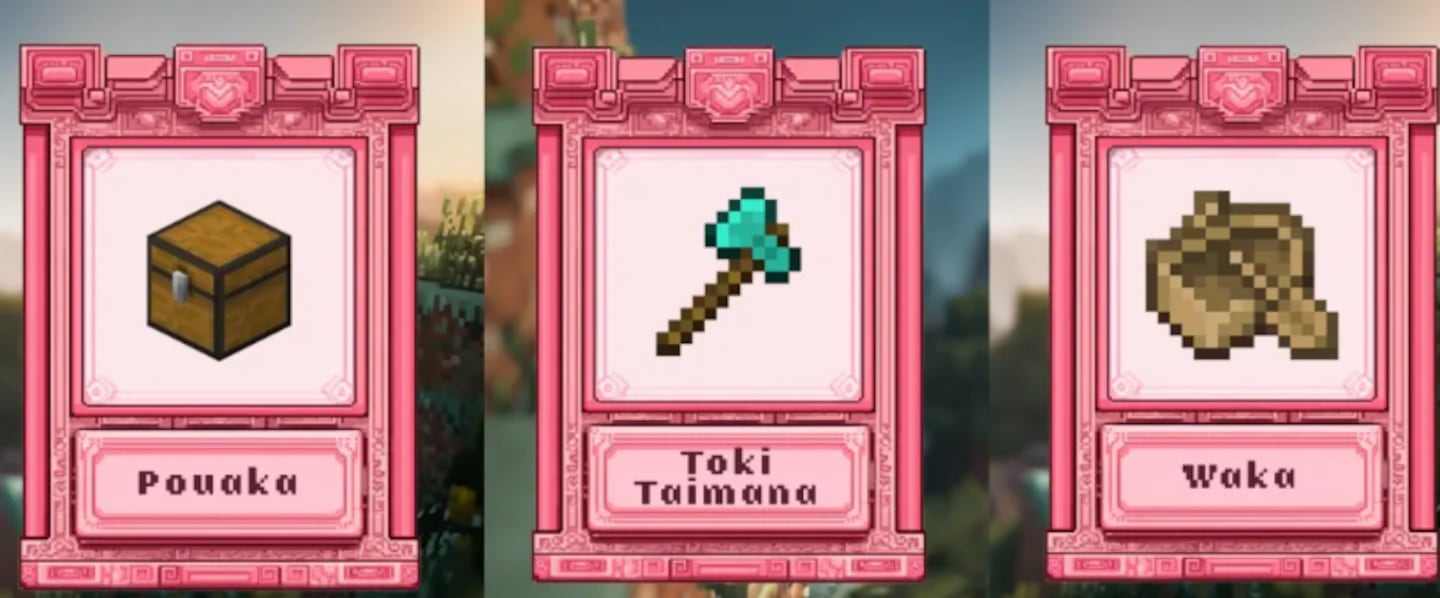Article originally published by RNZ
In a digital world dominated by quick reels and English-language content, one whānau is taking a creative approach to ensure te reo Māori has a space to thrive online.
Meet the Whangārei-based Ratapu whānau who are combining their love for te reo Māori with Minecraft.
‘Ahi Rara’, led by siblings Rehua, 6, and Autahi, 5, alongside their parents Chantell and Tama Ratapu, blends a love for Minecraft - or Mahi Maina - with te reo Māori, creating content that’s both educational and playful.
The haerenga (journey) began with a simple observation: their tamariki were spending hours watching content online, but very little of it reflected their language or culture.
“Our kids are watching this quick, easy, accessible content, but, you know, it’s all in English or Russian or other languages. Kei hea te reo Māori?” Chantell Ratapu told RNZ.
“That’s where we saw the gap as parents. What are our kids watching? Kei hea te reo?”
The solution, they said, was to bring te reo Māori into the games their children already loved.
“Mahi Maina! Mahi Maina!” Rehua said, expressing her excitement for the game.
‘Ahi Rara’, led by siblings Rehua (6) and Autahi (5), alongside their parents Chantell and Tama Ratapu, blends a love for Minecraft - or Mahi Maina - with te reo Māori, creating content that’s both educational and playful. Photo: Ahi Rara
Their pāpā said the girls were already engaging with Minecraft content, and he remembers how, even as babies, Rehua and Autahi would introduce themselves as if they were content creators.
“We just wanted to try and get the girls to speak te reo Māori. We thought, why not start something where we can help them build in Minecraft and speak te reo Māori at the same time.”
The ingoa, ‘Ahi Rara’ came from the girls’ own nicknames for each other - inspired by how they used to pronounce each other’s names as pēpi.
The Rautapu whānau said the kaupapa is about embedding te reo in everyday life. Photo: Ahi Rara
The kaupapa started spontaneously. A weekend pick-up of some microphones led to their first video, timed to coincide with Te Wiki o te Reo Māori.
“It was literally just decided to do it on Saturday before Te Wiki o te Reo Māori,” Chantell recalled. “And here we are. So yeah, it’s pretty cool.”
The kaupapa is also about keeping the reo fun and natural in their whare.
“It’s not just about being at kura or Mum and Dad making me speak te reo Māori and I don’t want to. We’re trying to bring that fun element into it.”
The Ahi Rara whānau create a variety of videos, from playful Minecraft builds to the beloved a, e, i, o, u waiata, freestyled by Rehua:
“A, mō te Ahi. E, mō te ekara. I, mō te ika. O, mō te oma. U, mō te ururangi,” she sang.
While these videos are a fun way of incorporating te reo, Chantell said they’re also a tool to help other tamariki embrace their language and culture.
“Growing up without the reo, and being whakamā to speak it as not a first language speaker, it’s about trying to normalise that. And if we can contribute to tamariki growing up and just naturally speaking it in their everyday lives, that would be amazing.”
The bubbly Rehua chimed in and agreed.
“We love sharing the videos with everyone, everyone in the whole wide world.”
The whānau deliberately keep their children’s faces private online, but their personalities shine through the screen through their characters ‘Ahi’ and ‘Rara’. Photo: Ahi Rara
A whānau reo journey
The kaupapa is also rooted in their parents’ personal journeys with te reo Māori.
Tama grew up immersed in te ao Māori, attending kōhanga reo and a bilingual kura.
“For me, I grew up with te reo basically since I was a baby. I was fortunate to be raised around marae so there were always kaupapa on. Growing up my whole life, I’ve always spoken te reo Māori.”
But as he grew older, Tama stepped away from te ao Māori, focusing on career pathways and navigating the challenges tangata Māori often face.
“I basically left that behind. It wasn’t until we had kids that it all started flooding back into our lives.”
Chantell’s reo journey, by contrast, has been about reclamation. Her whānau had lost the language, influenced by previous generations who discouraged te reo.
“The reo was lost in our whānau, as it was for many others,” she said.
“I’ve always yearned for it. But it wasn’t until having kids - actually, getting pregnant with Rehua - knowing that she was coming, that I realised, this is the time to make that difference. Start my own reo journey to make sure it’s normalised within these kids’ lives.”
Now, at home, te reo is the natural choice and they aspire to be a reo Māori-only speaking whare.
“On a daily basis, I would say, would you choose to speak English or te reo?” Chantell asked Rehua.
“Te reo Māori...me te English,” Rehua replied.
However, Chantell said, “If they had a choice, they’d probably stick with English.
“That’s another driver for why we’re trying to incorporate that fun. If you want to play your games, fine, as long as we incorporate te reo and bring that learning element into it too.”
6 year old Rehua said one of her favourite things about playing Minecraft is seeing her younger sister smile. Photo: Ahi Rara
Building the future
Beyond reels and short videos, the whānau plan to expand Ahi Rara.
“We’ve got aspirations to continue what we’re doing, and hopefully just hear more reo,” Chantell said.
Rehua and Autahi have dreams of creating merchandise, from T-shirts to pillowcases and even toys featuring their Minecraft characters.
Long-form YouTube content is also in the works, aiming to give young viewers something more substantial.
“Introducing māmā and pāpā as characters as well, navigating the survival world as a whānau,” Chantell said.
The whānau deliberately keep their children’s faces private online, but Tama said his tamariki are interested in one day having a ‘face reveal’.
“Autahi doesn’t like being talked about or shared on social media,” Chantell said.
“But this is kind of her outlet, where people are seeing the true Autahi that only those very close to her get to see. She’s happy being behind a character.”
Her older sister said one of her favourite things about playing the game is “seeing Autahi smile”.
The kaupapa is also about keeping the reo fun and natural in their whare, and the whānau hope others are encouraged to do the same. Photo: Ahi Rara
The Rautapu whānau encourage others to toitū te reo Māori.
“Any little bit of reo is better than nothing,” Chantell said.
“I’ve been on this journey for seven years. Just haere tonu and practise with your kids, because they don’t judge. As long as they can understand you, then you’re doing something right.”
And for anyone feeling shy about speaking te reo, Rehua offers a heartfelt message of aroha.
“If your whānau doesn’t know how to speak, just be yourself.”


